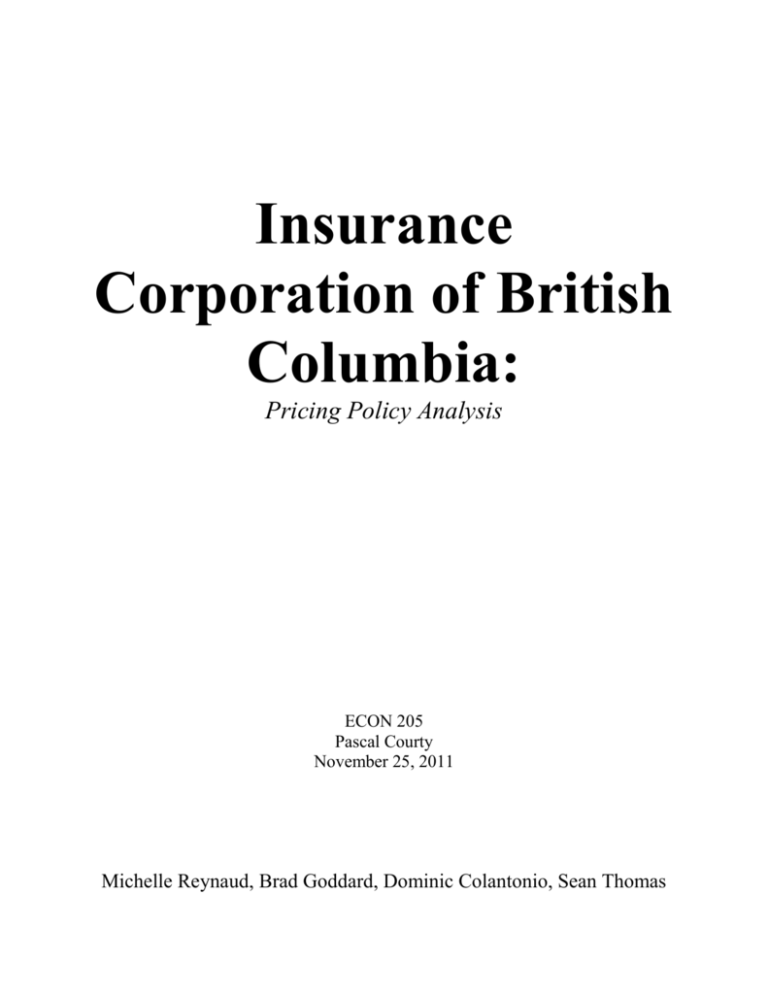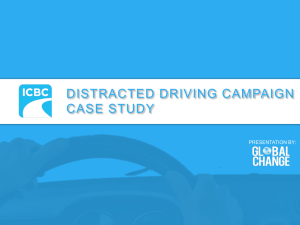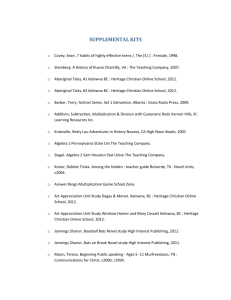Group 14: Reynaud/Goddard/Colantino/Thomas ICBC Pricing Policies
advertisement

Insurance Corporation of British Columbia: Pricing Policy Analysis ECON 205 Pascal Courty November 25, 2011 Michelle Reynaud, Brad Goddard, Dominic Colantonio, Sean Thomas ICBC: Pricing Policy |1 The Insurance Corporation of British Columbia (ICBC) was established as a crown corporation in 1973 by the B.C. NDP government to create and implement mandatory universal auto insurance for motorists (Tapley, 2005). According to the Insurance Corporation Act (1996), “all property and money acquired or administered by the corporation is deemed to be the property of the government for all purposes, including exemption from taxation.” While ICBC currently holds a monopoly on basic British Columbian auto insurance, the provincial government has permitted certain private firms to offer additional coverage on top of ICBC’s basic Autoplan policy (Young, 2001). This report will look at the pricing policies of ICBC and how these policies affect consumers as well as the corporation’s total revenue. Additionally, the manner in which ICBC’s pricing policy segments the auto insurance market will be evaluated. Finally, this report will conclude whether or not ICBC’s current pricing policy can be improved upon and suggest any potential changes that could be made. As the sole provider of British Columbian Auto Insurance, ICBC is a monopolist holding insurance policies for over 2.5 million lightweight vehicles in BC. Interestingly, BC drivers pay some of the highest premiums in Canada (rivalled only by Ontario, Manitoba and Saskatchewan) (Hasan, 2011). Although there several insurance brokers in BC, all insurance must be purchased and processed through ICBC. Essentially, every automobile in BC requires (at the very least) basic Autoplan coverage from ICBC which results in an extremely high demand for the service. As a vehicle and the corresponding insurance are perfect complements, prices of basic Autoplan insurance could theoretically be set at any point ICBC determines to be feasible. However, ICBC is a crown corporation and its prices are consequentially monitored by the British Columbia Utilities Commission (BCUC). One function of the BCUC is working to keep British Columbian Reynaud|Goddard|Colantonio|Thomas ICBC: Pricing Policy |2 auto insurance prices at a reasonable level in order to promote economic growth, as transportation-related demand accounts for approximately 12.2% of Canada's gross domestic product (ICBC, 2011). Demand for basic auto coverage is not overly price sensitive because the average consumer (assuming they don’t already own a vehicle) will usually decide whether or not to drive on the basis of vehicle price, rather than insurance price. However, a shift in insurance pricing could cause demand for insurance and vehicles to greatly increase or decrease. For example, if the price of insurance premiums fell dramatically, the likelihood of consumers insuring or selling old, unused or currently uninsured cars is significantly higher. Conversely, if the price of premiums increased, substitutes would be sought out immediately and the supply of used cars would increase substantially. Although there is no direct substitute for auto insurance, consumers can also choose to walk, cycle, bus, or carpool and consequentially decrease the number of insured cars in BC. As a result, ICBC has structured its pricing policy within BCUC regulations such that insuring one’s vehicle is financially possible for a very large portion of vehicle owners. Basic Autoplan coverage is at the highest point of demand for ICBC, as all additional coverage must be purchased after basic Autoplan coverage. To segment the market, ICBC offers extensive policies for consumers who are more risk averse than others or require greater coverage for an expensive automobile. For the average consumer who already has sufficient coverage, the marginal benefit of any additional coverage is very low. Consequentially, the demand for high-coverage policies is generally quite low. The majority of ICBC customers receive the highest average marginal benefit from a moderately priced policy with moderate coverage on their vehicle. Policies with low premiums, such as basic Autoplan coverage alone, Reynaud|Goddard|Colantonio|Thomas ICBC: Pricing Policy |3 allow consumers to legally drive their vehicles but cover the driver in few instances of accidents or other potential mishaps associated with vehicle ownership. On the contrary, high-coverage policies protect the holder in virtually any situation. However, the benefit from such a policy (for a generally cautious driver) would be much smaller than the cost. For these reasons, ICBC segments the market using direct and indirect price discrimination in order to capture the greatest amount of consumer surplus and consequentially maximize total revenue. ICBC’s pricing policies has been carefully structured to capture a large portion of the consumer surplus of most British Columbian drivers. ICBC uses both direct and indirect pricing policies to effectively differentiate between consumers. The market is directly segmented into four basic categories: location of current residence, claims history, vehicle history and desire (or lack of) for extra coverage. These segments are then indirectly segmented according to “rate class”; rate classes are ICBC’s categories for different vehicle uses. The basic rate classes are the four main uses of vehicles: business, commuting, delivery and pleasure. ICBC then breaks these categories down once more into more than 150 additional categories (a grand total of more than 2400 different categories!). ICBC’s pricing policy is individualized for each consumer so much that they have nearly achieved complete price discrimination. For example, a person that drives to a large city for work every day is subject to greater volumes of traffic than someone driving in a small community, and therefore their rates will be higher (unless that small community has a high rate of vehicle theft, wildlife-related accidents, etc.) . The current value of a given vehicle also has a great impact on amount of premiums paid. For example, insuring a luxury sports car is much more expensive than the cost of insuring a reasonably-priced family-size sedan as the cost to fix or replace a luxury car is much higher. The same can be said for accident history; the more Reynaud|Goddard|Colantonio|Thomas ICBC: Pricing Policy |4 accidents that someone has been in, the higher premiums they will pay, as they have been deemed to be a greater hazard to other motorists. The size of large commercial vehicles will result in higher premiums being paid, as if an accident occurs it will likely cause more damage cost much more to replace it than the average light vehicle. Interestingly, many consumers can (and do) lie about the intended purpose of their vehicle or current city of residence in order to save money on premiums. They will not be covered in the event that they have, for example, a policy only covering them in instances of pleasure use and are involved in an accident on their way to work. However, proving where a person intended to drive at a given time (and whether or not they’ve done it previously) is extremely difficult to do without constantly violating their privacy. This is the main area where ICBC fails to completely minimize their surplus. Information between policyholders and the firm is quite asymmetric (and completely asymmetric for a first-time policyholder with no driving record); insurance suppliers cannot directly monitor the actions of their policyholders (Png & Lehman, 2007). They can only differentiate between them using basic information about their vehicle, driving history, location and desire for extra coverage. Also allowing differentiation between policyholders is the option to purchase extended third-party liability or collision coverage in addition to basic Autoplan insurance (which already includes the minimum legal amount of third-party liability coverage, but no collision). Those who have third-party liability will be covered by their insurance up to a specified dollar amount in the event that they cause an accident involving multiple vehicles or otherwise and are found to be at fault. Those with collision coverage will pay a deductible in the event that they are involved in an accident and any additional damage will be covered by ICBC. Offering these services allows ICBC to differentiate between policyholders who are very risk averse and those who are not. Those who are risk averse are willing to pay at least the same Reynaud|Goddard|Colantonio|Thomas ICBC: Pricing Policy |5 amount for insurance as their expected loss without insurance (Png & Lehman, 2007), and the size of premiums that they pay are calculated and adjusted by ICBC accordingly. ICBC’s pricing policy is certainly an intricate one; it differentiates between policyholders using the personal characteristics (location, vehicle condition/intended use, driving record and need for various types of coverage) of each policyholder in such a manner that each buyer’s marginal benefit is very close to their marginal cost, but not equal to it. ICBC’s only real means of reducing its surplus further and achieve complete price discrimination is to invade the privacy of its policyholders. However, this is not only illegal, but the costs of doing so would be much greater than the benefits derived from it. In conclusion, we have determined that ICBC’s pricing policy is an effective one as its effectiveness likely couldn’t be increased without seriously violating the rights of its policyholders. Reynaud|Goddard|Colantonio|Thomas ICBC: Pricing Policy |6 Works Cited British Columbia. Insurance Corporation of British Columbia. (2011). Autoplan Insurance. Retrieved November 23, 2011 from http://icbc.com/autoplan Hasan, M. E. (2011). Canadian Student Review. Regulation and the Canadian Auto Insurance Market. Fraser Institute. Retrieved November 24, 2011 from http://www.fraserinstitute.org/uploadedFiles/fraser-ca/Content/researchnews/research/articles/regulatory-severity-in-the-canadian-auto-insurance-market_csr-fall2011.pdf Human Resources and Skills Development Canada. (2011, November 24). Environment – Transportation/Indicators of Well-Being in Canada. Retrieved November 23, 2011, from http://www4.hrsdc.gc.ca/.3ndic.1t.4r@-eng.jsp?iid=67 Png, I. & Lehman, D. (2007). Managerial Economics. (3rd ed.) Blackwell Publishing. Tapley, P. E. (2005). A Strategic Analysis of a Property and Casualty Insurance Broker in British Columbia. Simon Fraser University. Retrieved November 24, 2011 from summit.sfu.ca/system/files/iritems1/10126/etd1889.pdf Young. J. (2001). Down the Road: the Implications of “Full Competition” for Public Auto Insurance in British Columbia. Canadian Centre for Policy Alternatives – BC Office. Retrieved November 24, 2011, from http://www.policyalternatives.org/sites/default/files/uploads/publications/BC_Office_Pubs/down _road.pdf Reynaud|Goddard|Colantonio|Thomas








